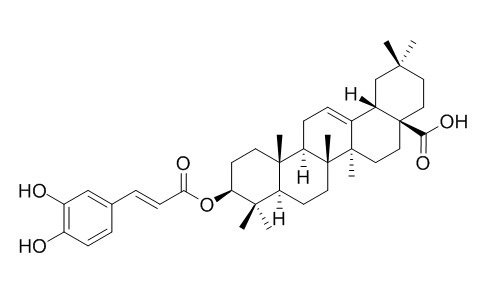3-O-Caffeoyloleanolic acid
3-O-Caffeoyl oleanolic acid exhibits in vitro cytotoxicity against the A549 cell line with the CC50 values of less than 20 ug/mL.
Inquire / Order:
manager@chemfaces.com
Technical Inquiries:
service@chemfaces.com
Tel:
+86-27-84237783
Fax:
+86-27-84254680
Address:
1 Building, No. 83, CheCheng Rd., Wuhan Economic and Technological Development Zone, Wuhan, Hubei 430056, PRC
Providing storage is as stated on the product vial and the vial is kept tightly sealed, the product can be stored for up to
24 months(2-8C).
Wherever possible, you should prepare and use solutions on the same day. However, if you need to make up stock solutions in advance, we recommend that you store the solution as aliquots in tightly sealed vials at -20C. Generally, these will be useable for up to two weeks. Before use, and prior to opening the vial we recommend that you allow your product to equilibrate to room temperature for at least 1 hour.
Need more advice on solubility, usage and handling? Please email to: service@chemfaces.com
The packaging of the product may have turned upside down during transportation, resulting in the natural compounds adhering to the neck or cap of the vial. take the vial out of its packaging and gently shake to let the compounds fall to the bottom of the vial. for liquid products, centrifuge at 200-500 RPM to gather the liquid at the bottom of the vial. try to avoid loss or contamination during handling.
Plants (Basel).2021, 10(5):951.
Int J Oncol.2019, 55(1):320-330
Univerzita Karlova2022, 228192.
Org Biomol Chem.2017, 15(31):6483-6492
Biomed Chromatogr.2022, 36(11):e5462.
Antioxidants (Basel).2024, 13(8):951.
J Agric Food Chem.2022, 70(51):16176-16187.
Biochem Systematics and Ecology2017, 11-18
J Food Drug Anal.2023, 31(2):254-277.
JEJU National University2022, 10478.
Related and Featured Products
Planta Med. 2000 Jun;66(5):485-6.
Cytotoxic triterpenes from stem bark of Physocarpus intermedius.[Pubmed:
10909277]
METHODS AND RESULTS:
Seven triterpenes (1-7), i.e., betulinic acid 1, ursolic acid 2, oleanolic acid 3, 3-O-Caffeoyloleanolic acid 4, euscaphic acid 5, 2 alpha-hydroxyursolic acid 6 and maslinic acid 7 were isolated from the stem bark extract of P. intermedius as active principles responsible for the cytotoxicity against five cultured human tumor cell lines, i.e., A549 (non small cell lung), SK-OV-3 (ovary), SK-MEL-2 (melanoma), XF498 (central nerve system) and HCT-15 (colon), in vitro.
Molecules. 2014 Jul 4;19(7):9515-34.
Studies on cytotoxic constituents from the leaves of Elaeagnus oldhamii Maxim. in non-small cell lung cancer A549 cells.[Pubmed:
25000464 ]
Elaeagnus oldhamii Maxim. is a commonly used traditional herbal medicine. In Taiwan the leaves of E. oldhamii Maxim. are mainly used for treating lung disorders. Twenty five compounds were isolated from the leaves of E. oldhamii Maxim. in the present study.
METHODS AND RESULTS:
These included oleanolic acid (1), 3-O-(Z)-coumaroyl oleanolic acid (2), 3-O-(E)-coumaroyl oleanolic acid (3), 3-O-Caffeoyloleanolic acid (4), ursolic acid (5), 3-O-(Z)-coumaroyl ursolic acid (6), 3-O-(E)-coumaroyl ursolic acid (7), 3-O-caffeoyl ursolic acid (8), 3β, 13β-dihydroxyolean-11-en-28-oic acid (9), 3β, 13β-dihydroxyurs-11-en-28-oic acid (10), uvaol (11), betulin (12), lupeol (13), kaempferol (14), aromadendrin (15), epigallocatechin (16), cis-tiliroside (17), trans-tiliroside (18), isoamericanol B (19), trans-p-coumaric acid (20), protocatechuic acid (21), salicylic acid (22), trans-ferulic acid (23), syringic acid (24) and 3-O-methylgallic acid (25). Of the 25 isolated compounds, 21 compounds were identified for the first time in E. oldhamii Maxim. These included compounds 1, 4, 5 and 8-25. These 25 compounds were evaluated for their inhibitory activity against the growth of non-small cell lung cancer A549 cells by the MTT assay, and the corresponding structure-activity relationships were discussed. Among these 25 compounds, compound 6 displayed the best activity against the A549 cell line in vitro (CC50=8.56±0.57 μg/mL, at 48 h of MTT asssay). Furthermore, compound 2, 4, 8 and 18 exhibited in vitro cytotoxicity against the A549 cell line with the CC50 values of less than 20 μg/mL at 48 h of MTT asssay.
CONCLUSIONS:
These five compounds 2, 4, 6, 8 and 18 exhibited better cytotoxic activity compared with cisplatin (positive control, CC50 value of 14.87±1.94 μg/mL, at 48 h of MTT asssay). The result suggested that the five compounds might be responsible for its clinical anti-lung cancer effect.



